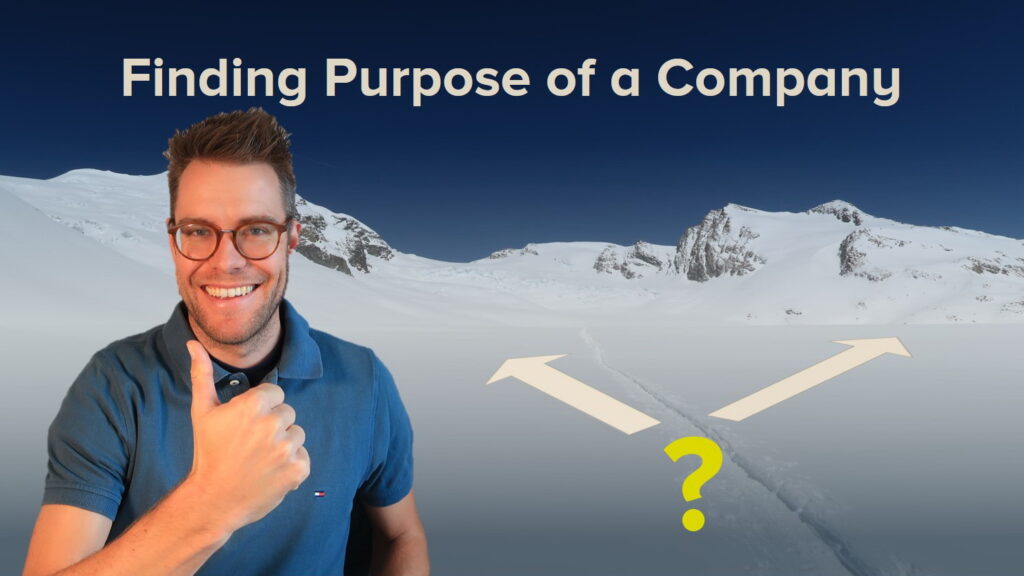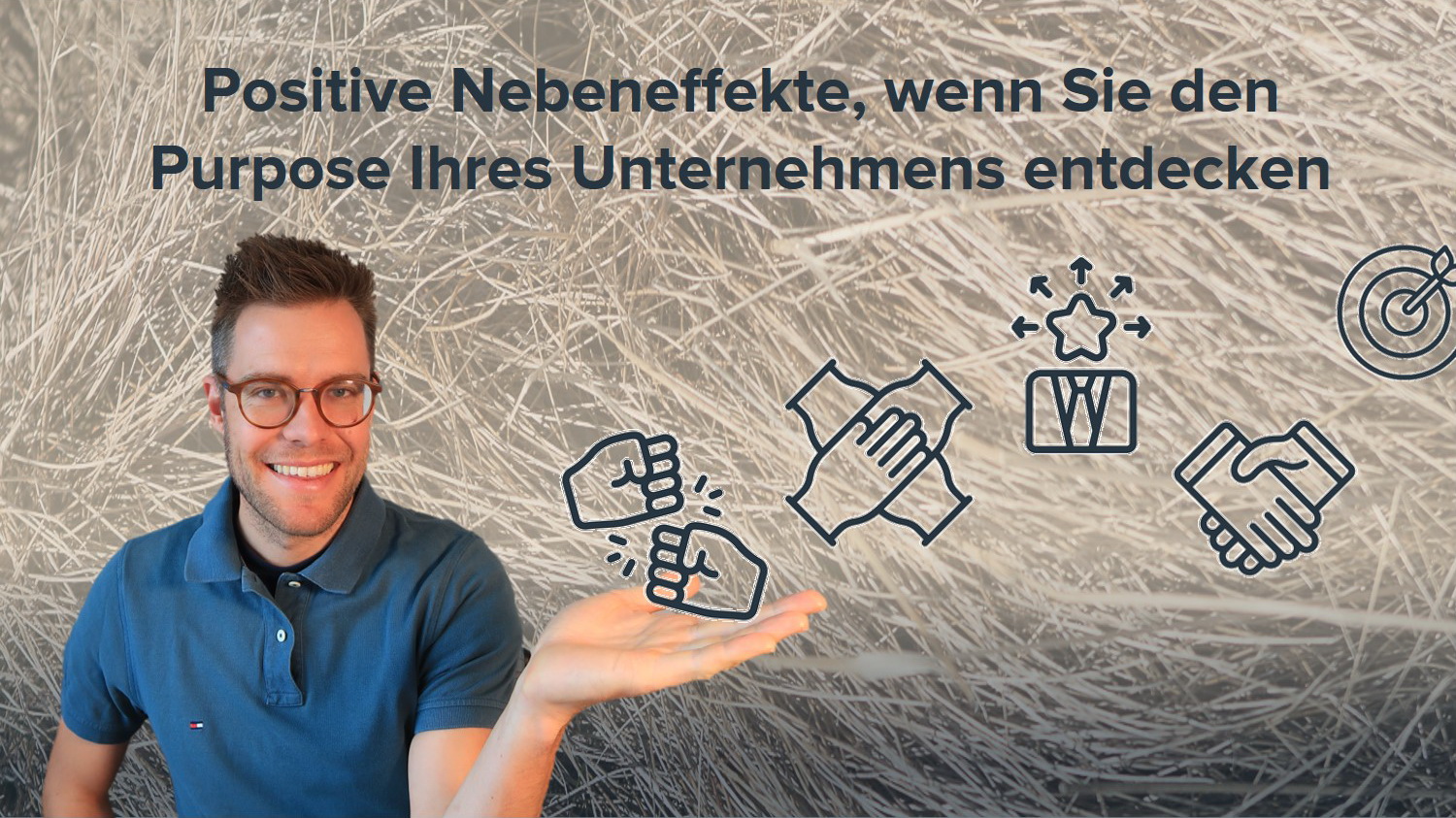The purpose of a company tells us: WHY does our company exist? Why do we produce the products or provide the services we offer? In this article I show that the purpose of a company is a valuable resource of the company and that it can easily be found by the employees in a workshop. The purpose has a great impact within the company and externally.
Inhaltsverzeichnis
What is the purpose of a company?
The purpose of a company tells us why the company exists and what contribution the company makes to society with its services/products or with its business activity as a whole. And this fosters motivation and creates a sense of belonging inside and outside the company.
The purpose of a company is not: we contribute to society by paying taxes.
The purpose is an important part of the corporate identity and sets the strategic direction of the company. Unlike most other strategic tools such as mission, vision, goals, values, etc., purpose is not an aspirational or future goal. The purpose has already been demonstrated in the past and can be discovered accordingly. If you want more information on how purpose can be used in business strategy, you will find it here.
Why should a company know its purpose?
Purpose is a very valuable, historically grown resource of the company. It is a source of motivation and connects the employees with each other, it sets the direction of the business and binds customers, partners and employees to the company. The purpose has a similar effect on employee behaviour as the other elements of the mission statement. And yet, the purpose is much more practical and tangible because it can be linked to examples in the past, experienced every day and communicated with stories. For this reason, in my view, it is at least as important as mission, vision etc.
How the provision can be used in the company is explained below.
The Golden Circle by Simon Sinek
To talk about the abstract topic of purpose, I like to use Simon Sinek’s famous concept: Golden Circle. According to Simon Sinek, it is not WHAT we do or HOW we do something, but WHY we do it (see figure below). And this at every level – person, group, company. This WHY is the purpose of a company.

I like the example of the Italian coffee machine manufacturer La Marzocco. They make coffee machines, but they are really about people meeting and sharing over a cup of coffee. The company supports this with many events where people can meet and share their enthusiasm for coffee and its preparation (Sinek, Mead, & Docker, 2002). For more information on the La Marzocco example and ideas on how the company could further expand your business, see the following blog article.
Approach to finding the purpose in a company
The purpose of a company cannot simply be derived from the products and services the company offers. For example, the purpose of a coffee machine manufacturer is not automatic: we make coffee machines so that people can get going and work in the morning. However, the purpose can be easily found. There are two ways to do this:
Founder or founding team
If the founders or the founding team are still available, it is a good idea to seek purpose with these people. Since the purpose of a company is often formed in the founding phase, it is very easy to ask the visionaries of the company: Why was the company founded? What was the vision? Which (social) problem did they want to solve with which approach?
Mixed group of employees with healthy culture (Tribe Approach)
If the founders are no longer available, a group of active employees can also be brought in. Participants in the workshop should be people who represent the diversity of the company (both new and long-term employees from the different areas). It is important that the participants are truly passionate about the company, care about the company and share the culture. Approximately 10-15 people should participate.
Special group in company with dysfunctional culture / collaboration
Sometimes a whole organisation and its collaboration is very dysfunctional or there are different silos with poor collaboration. Then one can perhaps still identify a team that still has a healthier (historical) culture and cooperation and try to transfer the culture from this team to the whole organisation again. If such a group is also no longer to be found, then the causes should first be eliminated before a new purpose is found. For this, contact an external consultant who supports you in this process, for example evores.
Workshop to find the purpose
The general procedure for the workshop is as follows:
As explained above, the purpose of a company has already been shown in the past and is often formed in the early history of a company. For this reason, it is necessary to look for stories, projects and experiences from the company’s past to find the purpose of a company.
- Introducing the concept and context
- Collecting concrete projects and experiences in groups
- Why did you start working for this company? What inspired you the most?
- What do your customers do or feel when they use/purchase your offers?
- Analyse stories and find recurring themes
- Create a WHY statement in the group
- Test and refine statement
- Share WHY statement, use in the company
The process is optimally organised and accompanied by a core group. Because it is very important that the right questions are asked in the process. This task is also fulfilled by evores as an external consultant (to the offer). The workshop is often divided into two sessions. In a first meeting, steps 1-4 are implemented and in a second workshop step 6 is discussed. Step 5 can be implemented by the core group in between.

Does every company have only one purpose?
Every company has a purpose. In the case of individuals, it is often the case that in the course of life new activities are added which, at first glance, have no connection to an already found purpose. On closer examination, however, a new common denominator is found between the different stories. One has then found a new overarchingpurpose. So the old formulation has only covered part of it.
In larger companies, it is also possible for subcultures to form. This shows itself in a different way of working together, a different atmosphere in the rooms or perhaps also in that the team members do more together besides work. There is a separate WHY for all these groups and, depending on the company, it may also make sense to have a separate workshop for special teams. However, it is important to connect these subcultures as well and formulate an overarching purpose for the company. Otherwise, there is a high chance that counterproductive silos will form which make cooperation and exchange difficult.
How can the purpose of the company be used internally and externally?
How far you want to share and use the provision is up to you. Communicate the provision internally within the company in order to
- Connect and motivate team members
- Increase autonomy of employees (make decisions in line with the purpose)
- Examine the company’s strategy: new products, services, business areas or acquisitions
- Influence corporate culture and promote desired behaviour
It will be clear to the team why they are here and what they are working for. This leads to motivation to make a personal contribution. In addition, the general direction of travel is clear and staff can make autonomous decisions in line with this. Below are the links for two more detailed blog posts on this topic.
In order to have long-term success with purpose and also keep the issue in the minds of employees, there are several ways. One way is to regularly share success stories of the company in the context of purpose with the employees, so that it continuously serves as motivation and inspiration. It helps a lot that the purpose can be told through concrete stories.
Further information and sources
evores supports you and your team on the whole journey, from discovering the purpose in a group, to applying it in the company, to using it in a strategic context. Contact me to learn more about the possibilities.
Book Invincible Company: Osterwalder, Alex, Pigneur, Y., Etiemble, F., & Smith, A. (2020). The Invincible Company. Strategyzer.com.
Book Find your WHY: Sinek, S., Mead, D., & Docker, P. (2002). Find Your Why. A practical guide for discovering purpose for you and your team.
More blog posts on the subject
-
Ein WARUM Workshop ist der Anfang, nicht das Ende
Der Unternehmenszweck ist ein mächtiges Instrument, das Unternehmen zum Erfolg führen kann. Viele Unternehmen tun sich jedoch schwer damit, ihren Unternehmenszweck in ihr Tagesgeschäft zu integrieren, und oft landet das frisch ausgearbeitete WARUM nach einem erfolgreichen Workshop in einer Schublade. In diesem Artikel gehen wir der Frage nach, was Unternehmen tun können, um sicherzustellen, dass…
-
Positive Nebeneffekte, wenn Sie den Sinn Ihres Unternehmens entdecken
Es ist eine Reise für sich, den Sinn (Unternehmenszweck, WARUM) eines Unternehmens zu entdecken. Oft geschieht dies im Rahmen eines ein- bis zweitägigen WARUM Workshop mit einem gemischten Team mit Personen aus verschiedenen Abteilungen und Ebenen des Unternehmens. Dieser gemeinschaftliche Prozess hat aus meiner Erfahrung viele positive Nebeneffekte, die über die Formulierung des Unternehmenszwecks hinausgehen.…
On the author

Claudio Lehmann is founder and consultant at evores. As an engineer and management consultant, he is fully committed to making the existing potential in companies visible and utilising it. Long-term sustainability starts with motivated employees and goes through efficient collaboration to the innovative strategy of companies that bring value to society. People. Planet. Profit.
Get in contact with me!
Article keywords

